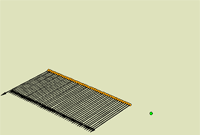
| Sankt - Petersburg State University | |||||
Condensed state theory group |
|||||
|
"Magnetism of low-dimensional metallic structures Fe/Cr and FeNi3/g -Fe interfaces: spin density wave materials with ferromagnetic interfaces"Final report Summary
Magnetic and transport properties of artificially made low-dimensional structures - series of multilayer samples Al2O3/[57Fe(tFe)/Cr(tCr)]n and MgO/[57Fe(tFe)/Cr(tCr)]n with different thicknesses tFe of Fe and tCr of Cr layers, the Fe/Cr multilayers consisting of continuous Cr layers and discontinuous clustered Fe layers, (110)-surface of mono crystal FeNi3 - were investigated using wide range of experimental methods. Among these methods are magnetometer measurements over temperature range from the liquid helium to the room temperature, polarized neutron reflectometry, Mossbauer spectroscopy, polarized electron spectroscopy etc. Intimate correlation between conditions of epitaxial growth and non-collinear magnetic structure have been observed. Experimental research revealed a microwave analogy of static giant magnetoresistance effect in Fe/Cr multilayers. Investigations have shown that essential information about magnetic structure can be obtained from magneto-acoustic measurements. The distribution of magnetic moments within the Periodic Anderson Model (PAM) for Fe/Cr superlattices with various interface roughness were computed. Special random algorithms were developed for the modelling of (i) stepped interfaces with different average size of the steps (ii) interface alloying. A new approach for the interpretation of photoemission data and magnetic dichroism experiments was suggested. The self-consistent calculations of the magnetic moment distribution for alloyed interfaces display strong correlation with the hyperfine fields on Fe nuclei, measured by the Mossbauer spectroscopy. It allows us to connect the hyperfine field with specific environment of the interfacial Fe atoms and leads to the essential correction of the empirical approach for the interpretation of CEMS spectra. From this we propose a new criterion to test the smothness of the interface using Mossbauer data. A new method for self-consistent calculation of a vector distribution of magnetic moments near rough Fe/Cr interfaces within PAM was proposed. The calculations were performed for superlattices with different step's width at the interface. We have proven that the magnetic frustrations in the interface region lead to the non-collinear orientation of magnetic moments near steps. This non-collinear ordering penetrates on a large distance from the interface in both Fe and Cr layers and leads to the non-collinear magnetic coupling between Fe layers through the Cr spacer. This is clearly one of the very first "electronic structure calculation" displaying this essential non-collinear structure of Fe films through the Cr spacer. Our calculation being performed -at the atomic level- we can claim that "any experimental sample" presents a necessary non-collinear coupling between Fe films in Fe/Cr superlattices due to interface roughness. A new code for the calculations of the electronic and magnetic structure of small 3d-clusters deposited on the metallic nonmagnetic substrate was developed. In the case of 3d trimers with a triangular structure the ground state obtained is essentially non-collinear. We can therefore claim that ANY calculation of these small clusters with the constraint of collinear spin direction does not give the ground state but only some kind of "metastable configuration" and is therefore absolutely -useless- for any comparison with experimental results. When an external magnetic field is introduced in the model a few metastable self-consistent solutions were found for trimer-clusters. The evolution of these solutions versus the magnetic field strength and the geometry of the trimer was investigated. The ab initio calculations of Fe/V superlattices under hydrogenation were performed. Electronic and magnetic structure of the Fe/V superlattices with and without hydrogen in the vanadium spacer were investigated using a relativistic full-potential linear muffin-tin orbital method. A short-range induced spin polarization in V as well as reduced Fe polarization at the Fe/V interface were obtained. The value of the magnetic moment induced on the V atoms depends strongly on the distortion caused by the lattice mismatch and the hydrogen loading whereas the total moment of the Fe and V interface layers remains almost unchanged. Hydrogenation of the V spacer leads to a decrease of the interface magnetic moment on the V atoms and to a reduction of the density of states (DOS) at the Fermi level. A low DOS could be one of the reason for the increase of the resistivity of the sample under hydrogen loading and leads to the disappearance of the antiferromagnetic interlayer exchange coupling in the Fe/(VH) superlattices for large hydrogen concentration. The doping of the V film by a gold monolayer increases the DOS at the Fermi level so that one could recover the antiferromagnetic interlayer coupling.
|

|
|||||
Сектор теории конденсированного состояния |
|||||
| Санкт - Петербургский государственный университет |